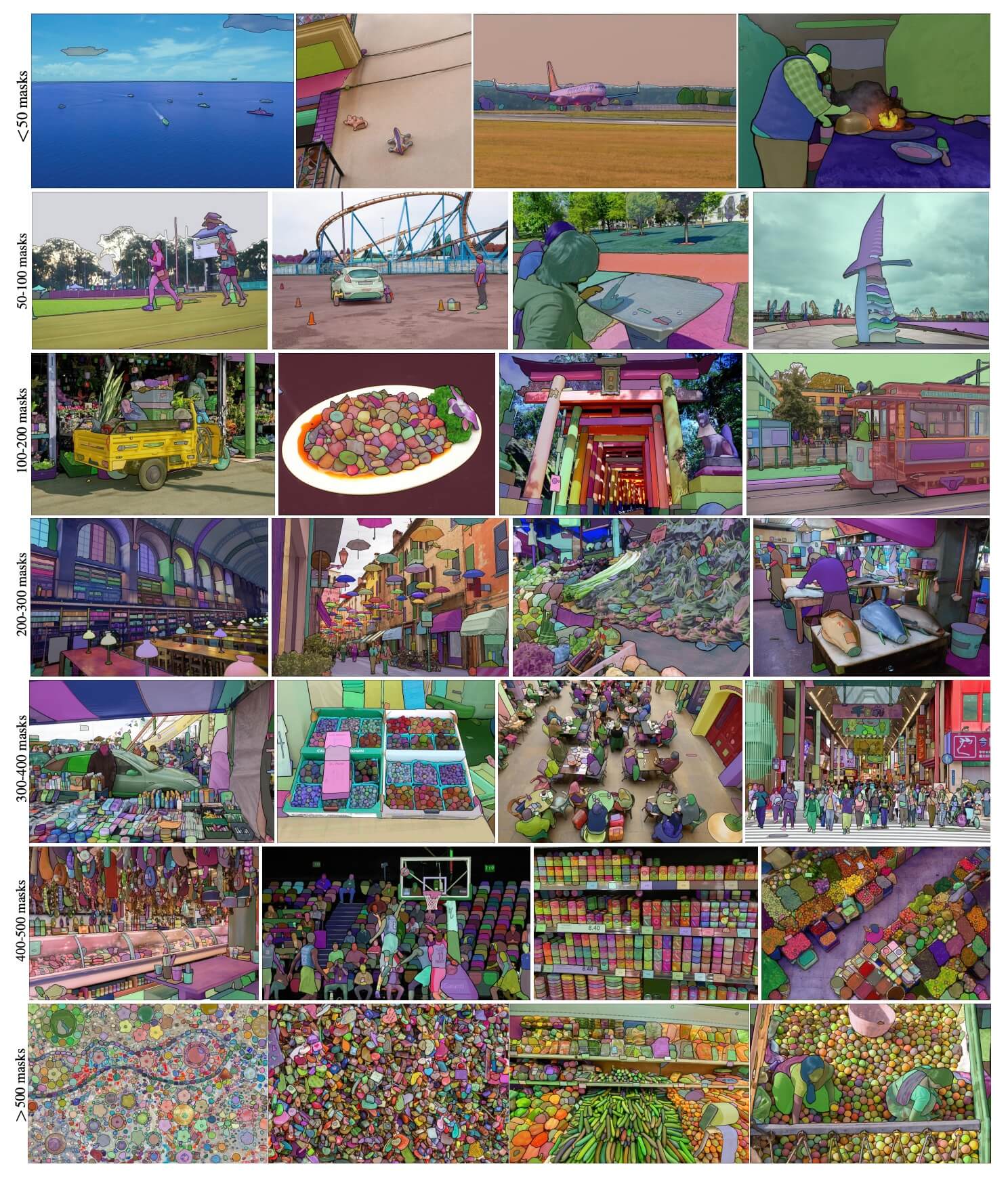6.6 KiB
| comments | description |
|---|---|
| true | Learn about the Segment Anything Model (SAM) and how it provides promptable image segmentation through an advanced architecture and the SA-1B dataset. |
Segment Anything Model (SAM)
Overview
The Segment Anything Model (SAM) is a groundbreaking image segmentation model that enables promptable segmentation with real-time performance. It forms the foundation for the Segment Anything project, which introduces a new task, model, and dataset for image segmentation. SAM is designed to be promptable, allowing it to transfer zero-shot to new image distributions and tasks. The model is trained on the SA-1B dataset, which contains over 1 billion masks on 11 million licensed and privacy-respecting images. SAM has demonstrated impressive zero-shot performance, often surpassing prior fully supervised results.
 Example images with overlaid masks from our newly introduced dataset, SA-1B. SA-1B contains 11M diverse, high-resolution, licensed, and privacy protecting images and 1.1B high-quality segmentation masks. These masks were annotated fully automatically by SAM, and as verified by human ratings and numerous experiments, are of high quality and diversity. Images are grouped by number of masks per image for visualization (there are ∼100 masks per image on average).
Example images with overlaid masks from our newly introduced dataset, SA-1B. SA-1B contains 11M diverse, high-resolution, licensed, and privacy protecting images and 1.1B high-quality segmentation masks. These masks were annotated fully automatically by SAM, and as verified by human ratings and numerous experiments, are of high quality and diversity. Images are grouped by number of masks per image for visualization (there are ∼100 masks per image on average).
Key Features
- Promptable Segmentation Task: SAM is designed for a promptable segmentation task, enabling it to return a valid segmentation mask given any segmentation prompt, such as spatial or text information identifying an object.
- Advanced Architecture: SAM utilizes a powerful image encoder, a prompt encoder, and a lightweight mask decoder. This architecture enables flexible prompting, real-time mask computation, and ambiguity awareness in segmentation.
- SA-1B Dataset: The Segment Anything project introduces the SA-1B dataset, which contains over 1 billion masks on 11 million images. This dataset is the largest segmentation dataset to date, providing SAM with a diverse and large-scale source of data for training.
- Zero-Shot Performance: SAM demonstrates remarkable zero-shot performance across a range of segmentation tasks, allowing it to be used out-of-the-box with prompt engineering for various applications.
For more information about the Segment Anything Model and the SA-1B dataset, please refer to the Segment Anything website and the research paper Segment Anything.
Usage
SAM can be used for a variety of downstream tasks involving object and image distributions beyond its training data. Examples include edge detection, object proposal generation, instance segmentation, and preliminary text-to-mask prediction. By employing prompt engineering, SAM can adapt to new tasks and data distributions in a zero-shot manner, making it a versatile and powerful tool for image segmentation tasks.
from ultralytics import SAM
model = SAM('sam_b.pt')
model.info() # display model information
model.predict('path/to/image.jpg') # predict
Supported Tasks
| Model Type | Pre-trained Weights | Tasks Supported |
|---|---|---|
| sam base | sam_b.pt |
Instance Segmentation |
| sam large | sam_l.pt |
Instance Segmentation |
Supported Modes
| Mode | Supported |
|---|---|
| Inference | ✔️ |
| Validation | ❌ |
| Training | ❌ |
Auto-Annotation
Auto-annotation is an essential feature that allows you to generate a segmentation dataset using a pre-trained detection model. It enables you to quickly and accurately annotate a large number of images without the need for manual labeling, saving time and effort.
Generate Segmentation Dataset Using a Detection Model
To auto-annotate your dataset using the Ultralytics framework, you can use the auto_annotate function as shown below:
from ultralytics.yolo.data.annotator import auto_annotate
auto_annotate(data="path/to/images", det_model="yolov8x.pt", sam_model='sam_b.pt')
| Argument | Type | Description | Default |
|---|---|---|---|
| data | str | Path to a folder containing images to be annotated. | |
| det_model | str, optional | Pre-trained YOLO detection model. Defaults to 'yolov8x.pt'. | 'yolov8x.pt' |
| sam_model | str, optional | Pre-trained SAM segmentation model. Defaults to 'sam_b.pt'. | 'sam_b.pt' |
| device | str, optional | Device to run the models on. Defaults to an empty string (CPU or GPU, if available). | |
| output_dir | str, None, optional | Directory to save the annotated results. Defaults to a 'labels' folder in the same directory as 'data'. | None |
The auto_annotate function takes the path to your images, along with optional arguments for specifying the pre-trained detection and SAM segmentation models, the device to run the models on, and the output directory for saving the annotated results.
By leveraging the power of pre-trained models, auto-annotation can significantly reduce the time and effort required for creating high-quality segmentation datasets. This feature is particularly useful for researchers and developers working with large image collections, as it allows them to focus on model development and evaluation rather than manual annotation.
Citations and Acknowledgements
If you use SAM in your research or development work, please cite the following paper:
@misc{kirillov2023segment,
title={Segment Anything},
author={Alexander Kirillov and Eric Mintun and Nikhila Ravi and Hanzi Mao and Chloe Rolland and Laura Gustafson and Tete Xiao and Spencer Whitehead and Alexander C. Berg and Wan-Yen Lo and Piotr Dollár and Ross Girshick},
year={2023},
eprint={2304.02643},
archivePrefix={arXiv},
primaryClass={cs.CV}
}
We would like to acknowledge Meta AI for creating and maintaining this valuable resource for the computer vision community.